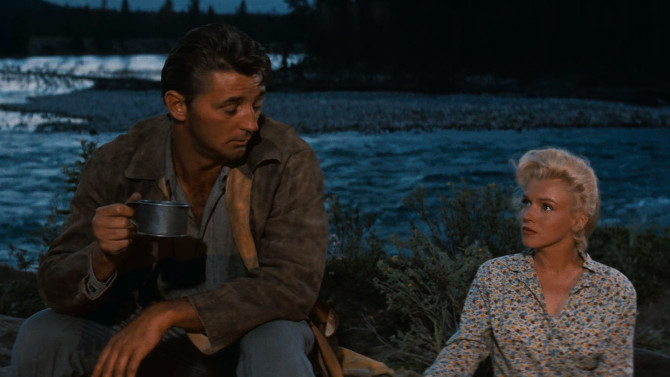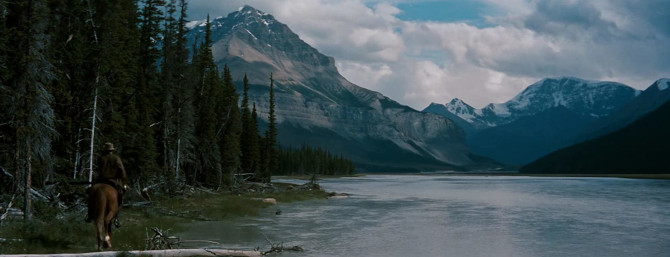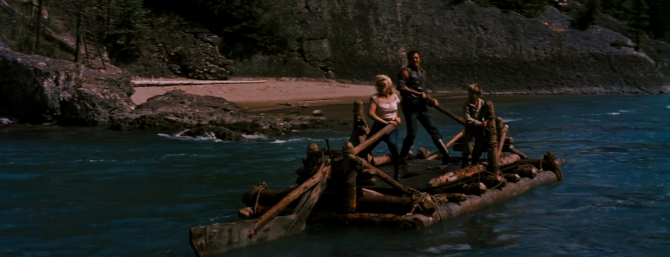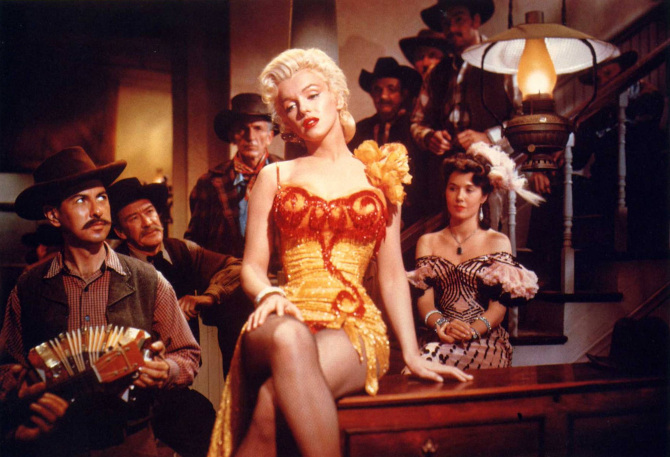Long before the wilderness of Alberta awed and amazed in Alejandro G. Iñárritu’s 2015 frontiersman epic The Revenant, it was widely featured in an impressive Technicolor CinemaScope picture, Otto Preminger’s 1954 western River of No Return.
Shot in the beauty of Banff and Jasper National Parks (though some of the river scenes are shot at Salmon River in Idaho – where the actual story takes place), the scrumptious background is matched by the glorious foreground. . . which held two Hollywood greats – the chiseled features of Robert Mitchum and a woman whose looks need no descriptors, Marilyn Monroe (a rather intriguing historical note finds the actress causing a pile-up on the main street of Jasper while walking down the street in her tight-fitting jeans that she wears throughout most of the movie).
Mitchum plays Matt Calder, a man whose back story could have been something found in a Johnny Cash song (I shot a man in the back, just to save my friend, now I’m stuck in prison, doing five to ten). Not having the chance to see his child, Mark (Tommy Rettig), grow up, upon being released (and hearing that the boy’s mother has recently passed), he organizes for him to be transported to a gold rush boomtown that he himself is making his way to.
Arriving before his father, the nine year old is fortunate to have a nightclub singer (or should I say night-tent singer – as nearly no solid edifices have been built yet) keeping an eye out for him. Kay Weston (Monroe) is a down on her luck dame, a woman who sings to drunk men to make a buck. In love with a grifting drifter, Harry Weston (Rory Calhoun), this card playing cheat has swindled (maybe) a chump out of his gold claim.
These two storylines meet once again when Matt and his son, now working the land near the titular river (perhaps the only farmers in this gold obsessed land – not too bad of a job when you see the fantastic Rocky Mountain vista off in the distance. . . though there is reason to be wary, as Indians constantly sit atop the nearby mountains – watching them), spot Kay and Harry struggling to flee the town upon a raft through the wild rapids – the card player fears the man he cheated may try to stake the gold claim in Council City before he gets there. Being the good Samaritans they are, the father and son haul them in, saving their lives. With Matt warning Harry that the river is too dangerous to traverse farther downstream, the desperate man bashes the father on the head with his own gun. . . stealing his rifle and horse to continue on his way.
Unwilling to leave the boy with his unconscious father, Kay stays. Now without the two most important things in the wild west, the Indians attack. Forced to escape the only way they can, the triumvirate brave the unruly river – Matt now turning his meanly focused eyes on revenge. Creating a rather precarious allegiance amongst the three, Matt steams constant fury at Kay, while she tries to mediate some sort of peaceful solution on behalf of her beau and the bloodthirsty man. With the kindly boy stuck in the middle, he too tries to understand why his father (who he idolizes), seems to hate the woman (who has only treated the boy with kindness and motherly love). Making for an intriguing combination of man vs. nature, as well as man vs. man, will this so-called ragtag team be able to traverse these dangerous lands, (dodging Indians, deadly animals, and equally desperate prospectors) to reach Council City? If so, what will they find there? Might a city named council provide some sort of peaceful reconciliation between the two men?
With a back story as interesting as the film itself, Preminger, a man who was infamously not easy to work for (when I interviewed Keir Dullea, who worked with the director on Bunny Lake is Missing, he literally called him “a terrible man to work for. . . a real bully”, furthering this vision by referencing his Colonel character – who runs the prisoner of war camp in Stalag 17, as him on a nice day), he clashed constantly with his stars. Mitchum, having issues with alcohol, drew his wrath. Yet it was not Monroe, but her acting coach, Natasha Lytess, who drew his ire. Ignoring Preminger’s direction and giving Monroe her own suggestions (including pronouncing every syllable very dramatically – something not suited for a wild west picture), this caused much strife in the process. Getting her fired. . . it didn’t take long for a disgruntled Marilyn to get her back onto the project (after all, the studio couldn’t lose their big box office draw), Preminger then targeted Monroe for the rest of the production. It was not until Lytess started to try to tell young Tommy Rettig what to do (Preminger’s favourite – he had a wonderful rapport with the child. . . who at the tender age of nine was able to smooth over some of the problems by having such a great bond with Monroe as well), impacting his confidence, that she was again ousted from the set (with the support of other cast and crew members this time). Other crazy happenings – Marilyn almost drowned during rehearsals (wrecking her ankle during the accident – a cast was needed, which slowed production); and perhaps not as crazy – constant clashes with producer Stanley Rubin.
Despite all this, Preminger came in on time and budget, with the finished product being quite impressive. Though it is by no means a masterpiece, it is an engaging western adventure. Its combination of Technicolor and CinemaScope makes for majestic vistas. . . mountains, forests, rivers, and so many other natural elements on full display through most of the picture. He also got solid performances from his stars. . . the constant clashes between Mitchum and Monroe believable, the former a fascinating vision of laconic coolness. . . that is, until his wild west animal nature rears its ugly head; while the latter is an intoxicating conundrum of naughty nightclub singer and innocent adopted mother. In many ways, she is not made for this world – truly believing in her fly-by-night fiancé, her unfortunate state in life has forced her into a combination of poor and unlucky decisions along the way. This bond with the grifter causing more pain in her life – as Matt now simply sees her as an offshoot of the criminal. All of this makes for good viewing. Now, to return to the visuals once more, Preminger and editor Louis R. Loeffler (Laura; Anatomy of a Murder) decide to slow the pacing down. . . a decision that really caught my eye (but might make viewing a bit slow for some modern watchers). Instead of editing the action at a brisk pace, sequences often linger for ten or more seconds. . . providing more time for us to absorb the all-round visions of beauty, as well as the actors and their performances. The nightclub sequences are very noticeable examples of this. In fact, according to IMDb, the average shot length is twenty seconds.
As beautiful today as it was back in 1954, River of No Return is a western still well worth seeing. Though its story might not be as powerful as some of the classics, it is perfectly serviceable, providing a solid backbone to show off all of the majesty of the film’s actors and northwest backdrop. A last note – it is actually one of the first films to use a blood squib to recreate the realism of a bullet wound. . . you’ll know the scene when you see it. So, turn back time and enjoy this river-raft fantasy, unlike its title suggests, it deserves a return.





